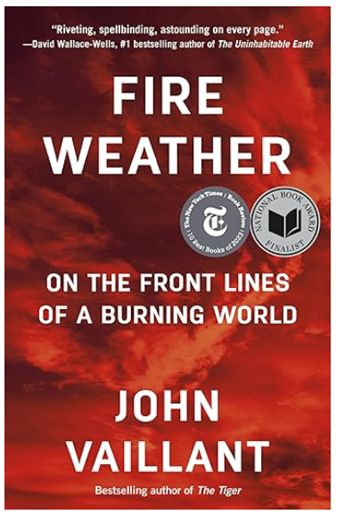By Jim Heffernan
The Los Angeles wildfires in January is what drew me to this book from last year. It may have started out as a dutiful trek in search of information, but I ended up being enthralled by his storytelling of the fire and learning about our new “Pyrocene” era. I understand why the book was in the New York Times list of the 10 best books of 2023.
The chief arch-villain of the book is the fire that started out being called “fire 009” and ended up known as “the beast”. He weaves another arch-villain into the book, our insatiable thirst for money and oil.
There is a large cast of heroes and victims, namely, Fort McMurray and its citizens and firefighters.
Fort McMurray is a oil boom town that sprung up in northern Alberta because of huge deposits of “tar sands” that were there. In 1966 its population was 2,615. In 2015, its population was over 125,000. Because of the fire and economic downturns its population is now 75,000. 88,000 were evacuated in the 2016 fire.
The fire burned with a ferocious intensity. When a house burned, all that remained would be piles of nails. Toilets and bath-tubs vaporized. Water sprayed into the fire by firehoses simply evaporated before touching the fire.
He introduced me to a new and different form on cognitive bias I had not encountered before, the Lucretius Problem a mental defect where we assume the worst-case event that has happened in the past is the worst-case event that can happen.
What we know of fires from the past really doesn’t apply to the fires of today.
Here’s an excerpt from page 92 that showcases his writing and adds another concept to describe who we are,
“To aspire—to breathe desire into ourselves and into our world—is what oxygen empowers (and condemns) us to do. If you look at how humans—undisciplined and unregulated by education or culture—use resources, they tend to consume whatever is available until it’s gone. Of course, fire does this, too. A key difference between us is that fire has no control over its appetite or rate of consumption, but we do, even if it’s hard to tell sometimes. Because of this capacity for self-awareness and self-control, science has generously named our species Homo sapiens, or “wise man.” In Latin, sapiens means not only “wise” but also “rational” and “sane”. However, given the degree to which our character and culture are now determined by our relationship to fire, and its avatar, the petroleum industry, there is a case to be made for a revised nomenclature. The energy historian Vaclav Smil suggested “hydrocarbon man”. I propose Homo flagrans. Flagrans is Latin for “ardent, fiery, passionate, outrageous”. In other words, “burning man”.
Here is an excerpt from from page 443, “It is almost unbearable to consider that our reckoning with industrial CO2 is only in its infancy, and that future generations will bear this burden far more heavily than we do now.”
I’ll close with an excerpt from an article he wrote for “The Guardian” this week when he happened to be in Los Angeles.
”It may sound cruel to say this, but you could see this fire coming a decade away, and many did. So, we need to be frank here: climate ¬science ain’t rocket science. If you can read a calendar and a thermometer, and you have noticed how laundry dries more quickly on hot, dry, windy days, you are well on your way to being able to predict the likelihood of wildfire. I am in southern California by sheer coincidence, visiting family, but the first thing I thought when I got down here was: “It’s January, and boy, those hills look dry – dry enough to burn.”
I was not aware there hadn’t been rain in eight months, or that this current drought follows the hottest summer in LA’s history, but you can see it, and you can feel it: the region is a tinderbox. All of SoCal could burn as viciously as LA is burning right now, as viciously as Valparaíso, Chile and the Texas panhandle burned last spring, or Lahaina, Hawaii did in 2023, or Australia in 2020, or Paradise and Redding, California in 2018, or Santa Rosa, California in 2017, or Fort McMurray, Alberta, in 2016. These fires are only the beginning of a historic reckoning that starts with the question: are fossil fuels liberating us or holding us hostage? There is a clear answer to this, and it can be found in the ledgers of petroleum and automobile companies, and with the investors, banks, governments, insurance companies, lobbyists, churches and media outlets that enable them.
As I write, late on Friday night (January 10th), the several major fires burning in and around Los Angeles are still spreading and multiplying at will, their containment still near 0%. (EDITOR’S NOTE: The fires are now about 50% contained – January 18, 2025 – but conditions continue to be problematic. Several local fire department crews have deployed to the Palisades and Eaton fires.) More strong Santa Ana winds are expected in the coming days, and there’s no relief in sight.
The same goes for survivors’ grief and rage and PTSD, injuries that may take lifetimes to contain, thousands upon thousands of them.”
Book is available at Cloud and Leaf Bookstore, Manzanita and Tillamook County Library. Published June 6, 2023 608 pages (200+ pages Acknowledgements, Notes, and Index) It really didn’t seem that long a book.
As always, discussion welcome at codger817@gmail.com


